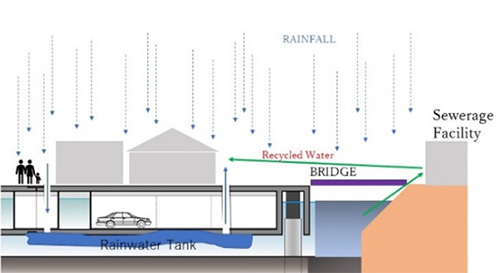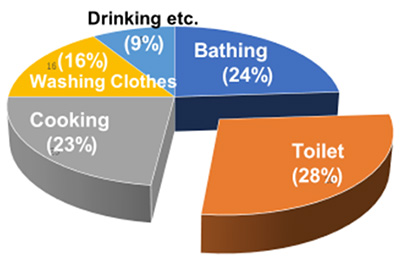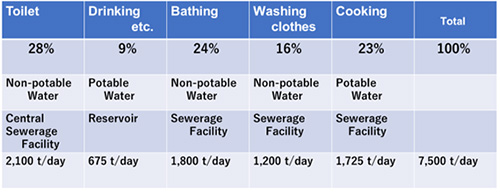
Multi-Dimensional Water Supply System
Multi-Dimensional Water Supply System in A Sustainable Water City
To maintain high water quality levels inside those artificial reservoirs, the gray water from the high-rise towers would first be purified by wastewater treatment facilities located nearby before being discharged into the reservoir. Furthermore, the water pumps placed in the reservoir would be designed to enhance water circulation within it while preventing eutrophication. Solar energy could be used to supply some of the power for the water purification facilities as well as to ensure continued operation during power failures. In addition, the rainwater that falls on the semi-floating water city residence would be stored in large-capacity, flexible, and durable tanks installed underneath the floating foundations, as shown in Fig. 1, where it would be treated for household use.

Fig. 1 Schematic Sectional View of Multi-Dimensional Water Supply System
The use of water for various living activities ranges from drinking and washing clothes to flushing toilets. Fig. 2 shows a breakdown of typical potable water usage in Japan during 2007. In many cases, potable water is used for purposes other than drinking or cooking. Hence, as described in the previous section, Dr. Tambo suggested that gray water be used in situations where potable water is not required.

Fig. 2 Typical Diagram of Potable Water Usage in Japan
In order to effectively use limited potable water sources in a sustainable manner, treated gray water should be used for purposes such as flushing toilets, watering lawns, or washing cars. Accordingly, in order to realize a sustainable and livable water environment, our semi-floating water city envisions a new approach in which an integrated hybrid water system uses treated gray water whenever possible, and potable water is restricted to drinking and cooking purposes.
Generally speaking, just a simple treatment is necessary to make collected rainwater potable. In a semi-floating water city, rainwater falling on the floaters will be collected to the maximum extent possible and stored in special elastic tanks emplaced underneath the floating foundations. The stored rainwater will be purified via a simple treatment process inside the floating foundations and then used as potable water. In contrast, the rain falling on the surface of the artificial reservoir and other areas of the floating units will be used as gray water for human activities such as toilet flushing, garden irrigation, and so forth.
Water Supply and Demand in A Singapore Water City
Assuming annual precipitation rates of 2,200 mm, a semi-floating water city constructed with a water catchment area of 40 ha can collect as much as 2,400 t/day of the rain falling on the collectors suspended above its 18 floating units. According to the data on Singapore water usage in 2009, the average amount of water used by each person for daily activities is 155 liters (0.155 m3/day per person). Hence, assuming a population of 48,400, the total amount of water necessary for a semi-floating water city is approximately 7,500 t/day. Since our envisioned design restricts potable water use to drinking and cooking, the rainwater falling on a semi-floating water city with a water catchment area of 40 ha is sufficient to supply its potable water needs. However, since this does not consider water losses due to unforeseen circumstances, it may sometimes be necessary to supplement the water city projects with PUB-supplied potable water in order to prevent water shortages.
Assuming a floating water city population of 48,400 persons, used potable water and reservoir water in amounts of approximately 5,100 t/day will be collectively purified by the water treatment facilities and then reused for non-drinking purposes. This water, combined with 2,400 t/day of treated rainwater (potable water), will have sufficient potential to provide the necessary 7,500 t/day required by the floating water city, based on the calculation of 5,100 t/day for non-potable use and 2,400 t/day drinking and cooking.

Table 1 Daily water demands in life for 48,400 residents
At the final stage, sewage water will be discharged by pipes into the PUB NEWater central sewerage treatment facility system and purified for further use.














